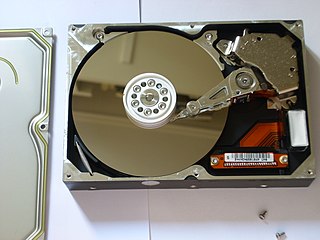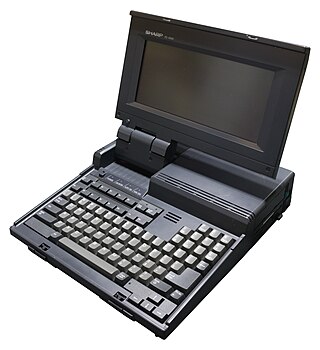
A hard disk drive platter or hard disk is the circular magnetic disk on which digital data is stored in a hard disk drive. The rigid nature of the platters is what gives them their name. Hard drives typically have several platters which are mounted on the same spindle. A platter can store information on both sides, typically requiring two recording heads per platter, one per surface.
Heat-assisted magnetic recording (HAMR) is a magnetic storage technology for greatly increasing the amount of data that can be stored on a magnetic device such as a hard disk drive by temporarily heating the disk material during writing, which makes it much more receptive to magnetic effects and allows writing to much smaller regions.

The LTE is a line of laptops manufactured by Compaq Computer Corporation, introduced in 1989 and discontinued in 1997. It was the first notebook-sized laptop sold by Compaq and the first commercially successful notebook computer, helping launch the burgeoning industry.

Travelstar was a brand of 2.5-inch hard disk drive (HDD) that was introduced by IBM in 1994 with the announcement of the Travelstar LP. At 12.5 mm high with two platters, they were available in 360, 540 and 720 MB capacities. Initial models were industry-leading for small form factor HDDs in terms of areal density, data transfer rates and shock tolerance (500g).
In 1953, IBM recognized the immediate application for what it termed a "Random Access File" having high capacity and rapid random access at a relatively low cost. After considering technologies such as wire matrices, rod arrays, drums, drum arrays, etc., the engineers at IBM's San Jose California laboratory invented the hard disk drive. The disk drive created a new level in the computer data hierarchy, then termed Random Access Storage but today known as secondary storage, less expensive and slower than main memory but faster and more expensive than tape drives.

The Deskpro 386 is a line of desktop computers in Compaq's Deskpro range of IBM PC compatibles. The computers feature Intel's 32-bit 80386 microprocessor. Introduced in September 1986, the Deskpro 386 is the first implementation of the 80386 processor in a computer system for sale to the public. It also marks the first time that a major component of the IBM Personal Computer de facto standard was updated by a company other than IBM themselves—in this case, upgrading from the 80286 processor of the Personal Computer/AT.

The Sharp PC-4500 is a line of laptop computers released by Sharp Corporation in 1987. The line comprises the PC-4501, the PC-4502, and the PC-4521. The PC-4501 is a bare-bones unit with only 256 KB of RAM stock, only one floppy drive, no backlighting, and no built-in numeric keypad; the PC-4502 and PC-4521 bumps the stock RAM to 640 KB and includes the latter two features while providing either two floppy drive (PC-4502) or one floppy drive and a 20 MB hard drive (PC-4521). Prices on the line initially ranged from $1,295 to just under $3,000; the PC-4501 was later sold for $995, becoming one of the first sub-$1,000 laptops available on the market. The PC-4500 line received mixed, mostly positive, reviews on its release in September 1987.

Librex Computer Systems Inc. was a short-lived American subsidiary of the Nippon Steel Corporation that manufactured notebook computers from 1990 to 1992. Librex had roots in Nippon Steel's Electronics and Information Systems Division (EISD) back in Japan, which starting in 1986 had formed joint ventures with several high-profile American computer companies. Librex was Nippon Steel EISD's first venture in the United States; it also set up Nippon Steel Computer PLC in the United Kingdom to sell identical products. The company's notebooks received praise in the technology press, but a fierce price war in the market for laptops in the early 1990s combined with dwindling profit margins compelled Nippon Steel to dissolve Librex in 1993.

The SupersPort is a line of PC-compatible laptops manufactured by Zenith Data Systems and sold from 1988 to 1993. The first two main entries in the SupersPort line included either an Intel 80286 microprocessor clocked at 12 MHz or an 8088 processor clocked at 8 or 4.77 MHz, switchable. Later entries included the 386SX, 486SX and 486 processors. The SupersPort 286 in particular was one of the top-selling laptops of the late 1980s, although Zenith's position in this segment faltered by the early 1990s.

Aox Inc. was a privately run American technology corporation founded by Michael and Linda Aronson in 1978. Over the course of its 22-year lifespan, the company chiefly developed software and hardware for IBM's PC and compatibles, for the Personal System/2, and for the Macintosh. In its twilight years, the company designed multimedia and teleconferencing devices and chip designs. Aox was founded after Michael Aronson graduated from Harvard University with a doctorate in physics; he stayed with the company until 2000, when he incorporated EndPoints Inc. and switched to full-time fabless semiconductor design.

Cumulus Corporation was an American computer peripheral and system manufacturer active from 1987 to 1993. Based in Beachwood, Ohio and started by Tecmar founder Martin Alpert, the company set out to exclusively manufacture expansion products for IBM's Personal System/2 (PS/2) family of computers—mainly RAM expansion cards. It later released cross-platform CPU upgrade cards and memory expansion cards for other platforms besides the PS/2. Beginning in 1990, the company began trading as Cumulus Computer Corporation and began releasing complete systems of their own. Initially a success story for the tech industry in Cleveland, a botched stock launch in 1992 proved disastrous for the company's ailing cash flow situation, and in 1993 the company was liquidated amid massive debt to suppliers and lenders.
Delta Computer Corporation was a short-lived American computer systems company active from 1986 to 1990 and originally based in Canton, Massachusetts. The company marketed a variety of IBM PC compatible systems featuring Intel's 8088, 80286, and i386 processors under the Deltagold name. Delta also marketed a variety of peripherals, namely modems. The company was well known for the styling of their products, bucking from the ubiquitous beige color of the vast majority of computer cases available on the market at the time by offering their computers in two-tone charcoal black, with gold trim. After a widely publicized failed move of their headquarters to Akron, Ohio, Delta filed for bankruptcy in 1990 and soon after disappeared from the market.

Future Domain Corporation was a privately held American computer hardware company active from 1982 to 1995 and based in Orange County, California. The company was among the first to produce Small Computer System Interface (SCSI) device controller expansion cards, later controller ICs. It was acquired by Adaptec in 1995 for US$25 million.

The LTE, LTE/286, and LTE/386s were a series of notebook-sized laptops manufactured by Compaq from 1989 to 1992. The three laptops comprise the first generation of the LTE line, which was Compaq's second attempt at a laptop following the SLT in 1988 and their first attempt at a truly lightweight portable computer. The LTE line proved highly popular—Compaq selling hundreds of thousands of units between the three—and gave way to successive generations of the line, including the LTE Lite, the LTE Elite, and the LTE 5000 series. With its use of industry-standard floppy and hard drive technologies, the LTE was the first commercially successful notebook computer and helped launch the fledgling notebook industry, which had seen earlier attempts fail due to the use of novel but nonstandard data storage.

The Walkabout is a family of notebook-sized laptop computers introduced by Data General in 1989 and discontinued in 1993. The first entry in the line, simply named the Walkabout, was a battery-powered portable terminal capable of emulating multiple protocols; as well, it contains a rudimentary word processor, an autodialer utility for placing phone calls, and a real-time clock display and timer application for setting reminders. The successor to the first model, the Walkabout/SX, released in 1990, was an architectural redesign allowing the laptop to be used as a general-purpose IBM PC compatible. The penultimate entry, the Walkabout/320, increased its predecessor's i386SX processor clock speed from 16 MHz to 20 MHz, while the last entry in the line, the Walkabout/386SL, replaced the processor with Intel's portable-centric i386SL processor clocked at 25 MHz.

Jonos International, Inc., originally Jonos, Ltd. (JL), later Netcom Research, Inc., was an American computer company active from 1980 to 1992. The company sold a variety of computer hardware products and systems, including STD Bus peripherals, smart terminals, microcomputers, and portable computers. The company's Courier portable computer was the first microcomputer sold with Sony's then-new 3.5-inch floppy disk drives on its release in June 1982. Jonos' systems were widely used in the fields of construction, roadworks, machining, and military.

Intégral Peripherals, Inc., or simply Intégral, was an American computer hardware company based in Boulder, Colorado, and active from 1990 to 1998. It was the first company to manufacture hard disk drives with a platter diameter of 1.8 inches, smaller than the typical 2.5-inch hard drives used in laptops and other mobile devices. Initially met with market skepticism, Intégral found success in the mid-1990s with design wins in products by IBM, Hewlett-Packard, and Toshiba, among others. However, its investors dropping out of the company amid the 1997 Asian financial crisis caused the company to file bankruptcy in 1998, after which it was acquired by private equity firm H&Q Asia Pacific.
MiniStor Peripherals, Inc., was a public American computer hardware company based in San Jose, California, and active from 1991 to 1995. The company was the first to manufacture and market PC Card spinning hard drives, based on the 1.8-inch hard drive specification invented earlier by Intégral. The company briefly rode a wave of success in this market before dissolving amid bankruptcy proceedings in April 1995.
Avatar Systems Corporation, later trading as Avatar Peripherals, was an American computer hardware company based in Milpitas, California, and active from 1991 to 1998. The company focused on the production of 2.5-inch cartridge hard disk drives, initially through computer system builders as an OEM and, later, directly to customers as a vendor.
















